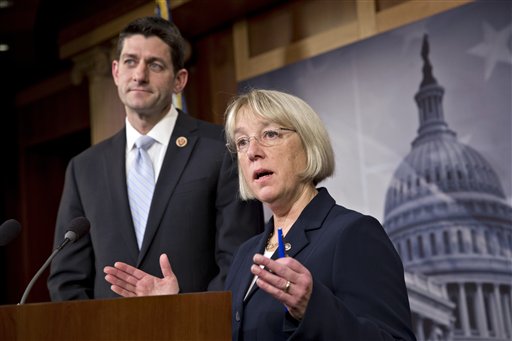On Tuesday, Rep. Paul Ryan (R-WI) and Sen. Patty Murray (D-WA) announced that they had reached a deal on the federal budget for the next two years. The GOP would agree to ease the sequester by $62 billion. In return, the Democrats would agree to $85 billion in cuts to entitlement spending over the medium term. There would be new revenues, but no new taxes, and the long-term budget deficit would fall–assuming nothing changes.
That is a major assumption. Entitlement spending is “mandatory,” but changes to entitlement spending are not permanent. On the surface, the deal looks like more of the usual: spend now, pay later. The best argument for the deal is that it avoids some deeper military spending cuts by requiring federal employees to contribute more towards their own pensions–i.e. it shifts the burden (slightly) to a broader set of government employees.
In sum, a weak trade. It would seem that Democrats have given up on some of their demands, such as an extension of unemployment benefits. Yet there is nothing to prevent them from making such demands separately. Meanwhile, the Republicans have given up the automatic sequester cuts–the one political success of the Tea Party-infused Congress, the only time since the Korean War that spending has dropped two years in a row.
Clearly the Republican leadership feared another government shutdown more than the Democrat leadership feared another year of sequester. The GOP is eager to focus on Obamacare. And there is merit to the argument: the shutdown in October gave Democrats the advantage in polls, while the failures of Obamacare swung polls the other way (dramatically). Yet to turn polls into votes, Republicans need to turn out the conservative base.
That is less likely to happen if conservatives feel that voting for a Republican majority simply means treading water until the next presidential election. Already, some conservatives are grumbling that the Ryan-Murray deal funds Obamacare–a contention that will interfere with the leadership’s hope to focus on an Obamacare message. Yes, the deal shows Republicans can compromise. But who is clamoring to be reassured on that point?
The Republican leadership seems to embrace polls-in-the-moment without considering what motivates their results. During the fiscal crisis in October, it focused on the fact that Obama’s refusal to negotiation was polling poorly. Yet once he agreed to “talks,” the GOP had no weapons left with which to fight, having failed to connect with the majority of voters who opposed an increase in the debt ceiling. The collapse followed soon thereafter.
Similarly, Republican leaders are now convinced they can run on Obamacare’s failures without understanding that what motivates the president’s bad polls is a collapse of trust. The GOP faces the same failing trust from a voter base that has seen Republican leaders accept Obamacare funding for Medicaid, vote for higher taxes, and generally fail to stand up to Obama effectively. Giving up the sequester will not improve that impression.
If Ryan were to trade the sequester at all, it ought to have been for something of real political value, such as a one-year delay in Obamacare. That would not have lessened Obamacare as an issue for 2014–if anything, that would have made it even more poignant–and Republicans would have had the added advantage of being able to show that they had done something to ease the suffering of millions losing their insurance and paying more.
Alternatively, Ryan could have insisted on the sequester–which was, after all, a White House proposal–and let Democrats know that the price of additional revenues would be real entitlement reforms. That might have led to another shutdown, but it is not as clear the GOP would have been blamed. After all, the Budget Control Act of 2011, which created the sequester, is the “settled law of the land.” Last time, that was a winning argument.

COMMENTS
Please let us know if you're having issues with commenting.